WordPress SQL Injection: Complete Protection Guide
by
7-layers of Security for Your WordPress Site
Your website needs the most comprehensive security to protect it from the constant attacks it faces everyday.
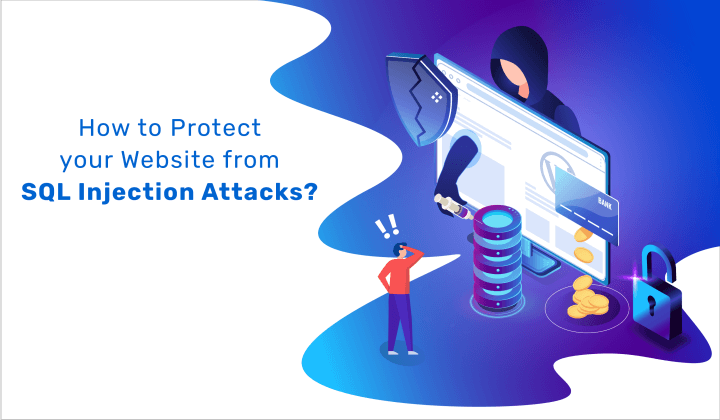
In all likelihood, you’re losing traffic, revenue, and the trust of your customers every day from your WordPress site because of something called ‘SQL injections’.
Why?
Simple – some hacker thought that it was a good idea to siphon your business traffic and lead them to:
- Adult sites;
- illegal drug sites;
- religious ads;
- or some other malicious site
It’s getting your site blacklisted on Google. You’re also losing the respect of your customers and community due to warnings like, deceptive site ahead, this site may be hacked in search results.
The worst part?
This nameless, faceless hacker doesn’t think that you can do anything about it.
Your site is now plagued by weird pop-ups, redirects, spammy keywords and 403 errors.
We have worked with more than a million WordPress websites for over a decade and come across these hacks all the time.
We have helped remove WordPress SQL injection malware from hundreds of websites before it could damage the site.
In this article, we are going to show you how you can get rid of this hack and get your site back to its original state as soon as possible.
TL;DR: To remove SQL injection from your site, install MalCare. It’ll clean your website under 60 seconds. And then beef up your security using MalCare’s security hardening features. That’ll keep your website protected from future SQL injection attacks.
Hacker bots are designed to carry out hundreds of SQL injection attempts within a few minutes.
One successful attempt will ruin your website.
If your firewall or security plugin detected dozens of SQL injection attacks, there’s a good chance that your website is already hacked.
If it’s not then you are lucky.
So how do you know for sure if your site is already hacked?
And if it is then how do you remove the malware?
Don’t worry, we’ll show you the exact steps you need to take to detect and clean SQL injection attacks on your site.
But before we get into that, it’s a good idea to try and understand what an SQL injection attack really is. However, if you urgently need to check your site for infection, then jump to this section.
What Is An SQL Injection Attack?
Your WordPress website uses a database to manage data like posts, pages, comments, etc. All this data is stored in an organized manner in database tables.
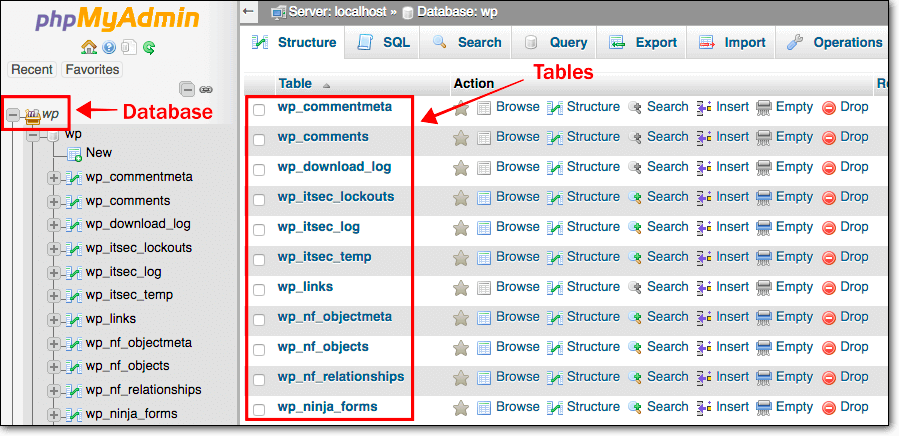
Hackers gain access to your database by carrying out SQL injection attacks.
But why would someone want to access your database?
Good question.
When hackers are trying to break into your website, they either intend to steal sensitive data (like login details and credit card information) or damage your site.
If malicious codes are inserted in your database with the intention to procure data, then it’s called In-band SQL injection. But if the intention is to harm your site by deleting content from your database, then it’s called Blind SQL injection attack.
We know what you are wondering – why is it called SQL injection attack?
For your website to store data in the database, it needs to be able to interact with the database. SQL is a language that your site uses to add, update, delete, and search data in the database. Hackers use the same language to try and hack the database.
They exploit the input fields on your websites like a contact form or the search bar to inject malicious scripts into the database. Hence, it’s called a SQL injection attack.
How to Remove WordPress SQL Injection From Your WordPress Site
Are you experiencing any of the following:
- Receiving hundreds of emails from your contact form within the span of a few minutes.
- Ads redirecting to suspicious websites.
- Strange popups are appearing on some pages and errors on others.
These are common symptoms of a SQL injection hack.
That said, this type of hack may not really be visible. Hackers may have hacked your site just to steal information. They don’t need to make any modifications to your site.
So while your site seems perfectly normal, it may still be hacked. You need to scan your site to be sure.
There are plenty of scanners to choose from. That said many scanning plugins cannot detect new, complex, or extremely well-hidden malware. We recommend MalCare because it’s ahead of the game by a mile. Here’s how:
- MalCare does not rely on pattern matching to find malicious codes. Instead, it comes equipped with intelligent signals that assess the behavior of the code. This enables the plugin to detect new and complex malicious codes.
- It scans not just the WordPress files but also the database. It looks into every nook and corner to find malicious codes or malware.
- It performs scans on its own server to ensure that your website is not overloaded.
- The plugin will automatically scan your site on a daily basis. And it will notify you only when it finds any malware.
To detect a hack with MalCare, you need to take the following steps:
Step 1: Sign up with MalCare’s WordPress Malware Scanner. Install and activate the plugin on your website. Then add your site to MalCare’s dashboard.
It will immediately run a scan on your site.
If it detects that your site is hacked, it’ll notify you.
You can go ahead and clean your website with the same tool.
Many of you are probably thinking of restoring a backup to clean the infection. This won’t work. Restoring a backup will replace only existing files, it won’t remove the malicious files added by hackers.
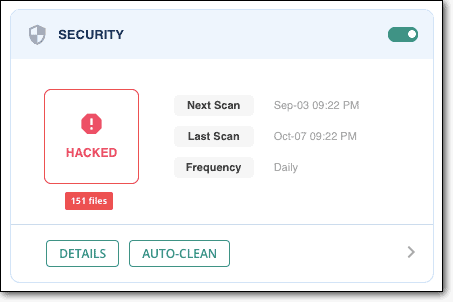
Fair warning: Although the scanner is free, MalCare’s malware removal is a premium feature. You will need to upgrade to clean your site.
To clean the hack, just follow the instructions below:
Step 2: Once MalCare detects that your site is hacked, it will notify you about it on its own dashboard.
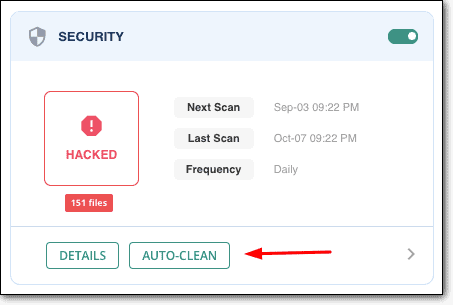
Right below the notification, you should see an Auto-Clean button. Click on it.
Step 3: Next, you’ll need to enter your FTP credentials. If you don’t know what they are or how to find them, this guide and these videos will help.
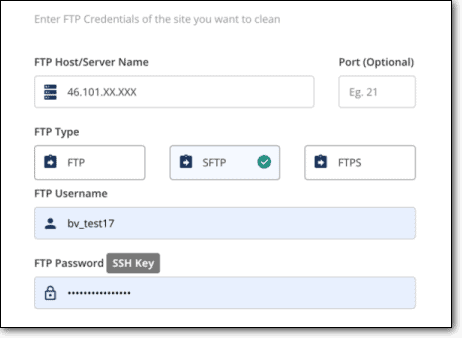
Step 4: Following that you will be asked to select the folder where your WordPress website is stored. Generally, it’s the public_html folder.
Some website owners move their site to a different location for safety concerns. So if you are maintaining a client website, then it’s a good idea to verify whether the site is actually located on the public_html folder.
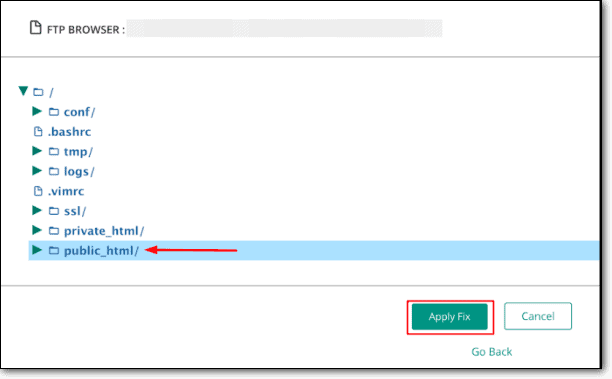
Once you have selected the folder, MalCare will start cleaning your website.
It’ll take them a few minutes to remove malware from your website.
Besides MalCare, there are many other security plugins that’ll help you detect and clean your site. Those are Wordfence, WebARXSecurity, Astra Security, Sucuri, etc. You can take any one of these for a spin.
How Does WordPress Handle SQL Attacks?
Over the years, WordPress has gone to lengths to try and secure the database from SQL injection attacks.
To protect WordPress sites against this type of attack, input fields have to first verify the user-supplied data before inserting it into the database.
WordPress has a list of functions that sanitize data inserted in the input fields making it impossible to insert malicious scripts.
However, WordPress sites are very dependent on themes and plugins. SQL injections are carried out by using vulnerable themes and plugins. More on this in the next section.
How Are SQL Injection Attacks Carried Out?
Hackers are able to access your website by exploiting a vulnerability present on your site.
In the case of SQL injection attacks, hackers exploit vulnerabilities in input fields of your website like contact forms, login boxes, sign-up boxes, comment sections, or even the search bar to insert malicious PHP scripts into the database.
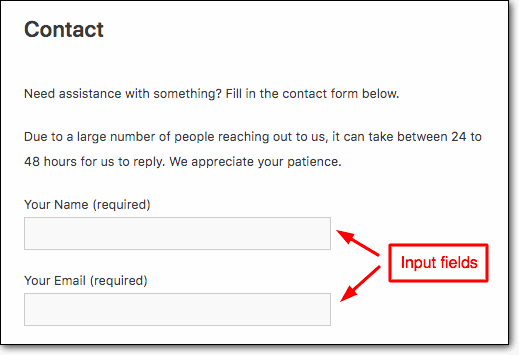
Does that mean having input fields are dangerous?
The answer is both yes and no.
Inputs fields like comments and contact forms are powered by plugins or themes. Like any other software, plugins and themes develop vulnerabilities which is then exploited by hackers to carry out SQL injection attacks.
It’s impossible to ensure that plugins and themes are following WordPress’s footsteps in preventing SQL injection attacks.
Let’s take a form plugin as an example.
The information inserted in the form plugin should be first validated and sanitized before storing them into the database.
But why validate and sanitize?
Data validation: It ensures that the data is received in a specific format. A form plugin accepting phone numbers should ensure that visitors are inserting only numeric characters.
Data sanitization: It ensures that you are not inserting more than what is required. The form plugin should restrict visitors from inserting more than 10 characters.
If the plugin is not checking visitor inputs then it’ll be easy to insert a string of malicious codes into the form.
The form will store this data into your database, giving hackers access to the database.
For most WordPress users, it’s impossible to know whether the plugin or theme installed on their site are carefully filtering user-supplied data.
That said, there are ways in which you can ensure that your site remains protected from future SQL injection attacks. To learn more about protecting your site from reinfection, jump to this section.
Impact of SQL Injection Attacks On Your Site
The consequences of a successful SQL injection attack is ugly. You may end up experiencing any or all of the following ramifications:
1. Loss of Sensitive Data
You must have heard of data breaches in Yahoo, Twitter, Adobe, etc leading to compromise of millions of accounts.
Your site is not as big as Twitter but it contains sensitive information which if stolen will lead to serious issues like breach of trust, damage to reputation, and even legal repercussions.
Ecommerce websites can have financial records stolen, medical sites will have health records stolen, so on and so forth.
Hackers can choose to sell these records online or ask for ransom.
2. Loss of Website Data
Once a site is breached, the biggest concern for hackers is getting caught.
This is why, they carefully maneuver through the site, carrying out activities quietly.
But on occasions, they may end up making modifications to the database. They can be a mistake and end up deleting a piece of information. Or it can be a deliberate act where the goal is to damage your website.
As a consequence, you lose your website content.
3. Breach of Trust & Reputation Damage
Data breaches are going to impact how your customers view your business and if they want to continue relying on your business.
The Cambridge Analytica data breach scandal in 2018 prompted people to delete their Facebook accounts.
When customers find out that you failed to protect their health or financial record, they are unlikely to ever want to do business with you.
You can be held legally liable for data loss which will definitely stain your reputation.
4. Google Blacklisting & Hosting Suspension
Hackers try their best to not get caught. They carry on their activities carefully and in secret.
Often there are no visible signs of a hack. So it may take a while for you to learn that your site is hacked.
Search engines and hosting servers are quick to pick on malicious activities in a WordPress site. And when they do, they quickly suspend your site to protect their own users and prevent them from accessing your site.
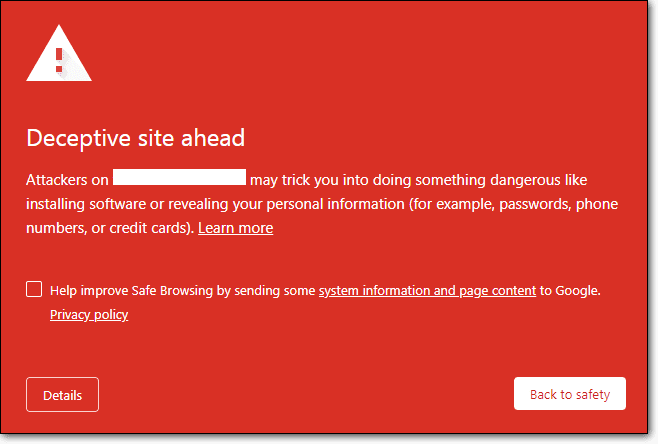
5. Cleaning Expenses
Cleaning a hacked site is no cakewalk. You can’t do it manually.
There are dedicated services you can resort to but it’s an expensive and time-consuming affair.
And if you keep getting infected, we hope you have deep pockets to clear the pilling bills.
Luckily, a security service like MalCare offers you unlimited cleanups for $99 per year for a single site. Check out MalCare’s pricing, if you haven’t already.
How Can You Protect Your Site From Getting Reinfected?
Your WordPress site was hacked due to a vulnerability in a plugin or theme.
After cleaning your site, you need to take measures to stop hackers to prevent reinfections.
1. Choose Themes & Plugins Carefully
Before installing a theme or a plugin on your site, read reviews from users.
If the tool has been developing vulnerabilities causing websites to get hacked, do not use it.
A well-built tool is unlikely to develop vulnerabilities very often.
Even when it does, it’s maintained by a group of responsible developers who will quickly release a better version.
This will keep your website safe.
2. Keep Your Website Updated
SQL injection attacks are successful because of vulnerabilities present in a theme, plugin or the core.
The vulnerability enables hackers to inject malicious code into a website and gain access to the database.
Such vulnerabilities can be fixed by applying an update.
When developers learn about a vulnerability in their tool, they release a patch in the form of an update.
If you apply that update, your website will be safe from SQL injection attacks.
It’s important to keep your themes, plugins and even the core updated.
Pro Tip: Ensure that WordPress automatic updates are enabled. Back in 2017, WordPress rolled out an update that patched SQL vulnerabilities. But still, a lot of websites were hacked because automatic updates were disabled.
3. Change Database Table Prefix
This will make it harder for a hacker to access the database.
Wondering how?
Your database has tables that start with “wp_”
Changing the prefix will make it harder to locate your tables.
Pro Tip: The first step is to take a backup of your site. DO NOT skip this step. Making any modifications in the backend of the site is dangerous. If something goes wrong, you’d have a copy of your site to fall back on.
> Access your wp-config file through your hosting account.
> Just log into your hosting account and go to cPanel > File Manager.
> Find the wp-config.php file and open it.
> From the sentence $table_prefix = ‘wp_’; replace wp_ with something else. Save and exit.

4. Use a Firewall
A firewall offers protection to a WordPress website from hackers.
It investigates everyone visiting your website and blocks those who have a record of malicious activities.
A firewall like Astra Security will analyze user inputs to detect and prevent SQL injection attacks.
If you used MalCare to clean your website, then you don’t have to worry about installing a firewall plugin. MalCare Firewall automatically blocks malicious traffic.
What Next?
A WordPress website is made up of a database and several files.
Just like the database, WordPress files are susceptible to hacks.
You need to take steps to protect them against hackers and bots. Here’s a guide that’ll help you do just that – How to Secure a WordPress Website.
While you can take many security measures, the one step that you cannot miss is that of using a security plugin.
A security plugin like MalCare will scan your site on a daily basis, notify you immediately if it’s hacked, it’ll help you clean the site under 60 seconds, and ensure that your site is protected from future hack attacks.
Protect Your Site 24×7 With MalCare Security Plugin
Category:
Share it:
You may also like

MalCare Ensures Unmatched Protection Against User Registration Privilege Escalation Vulnerability
Imagine discovering that your WordPress site, which should be secure and under strict control, has suddenly become accessible to unauthorized users who have the same administrative powers as you. This…

MalCare Ensures Proactive Protection Against WP-Members XSS Vulnerability
MalCare continues to protect its customer sites from all kinds of attacks, even the ones exploiting zero-day vulnerabilities. The recent stored cross-site scripting (XSS) vulnerability found in the WP-Members Membership…
![Top 9 ManageWP Alternatives To Manage Multiple Sites Easily [Reviewed]](https://www.malcare.com/wp-content/uploads/2022/12/malcare-default-image.jpeg)
Top 9 ManageWP Alternatives To Manage Multiple Sites Easily [Reviewed]
ManageWP is a popular name in the WordPress maintenance plugins market. People love how much you get for a free plan, how easy it is to set up, and how…
How can we help you?
If you’re worried that your website has been hacked, MalCare can help you quickly fix the issue and secure your site to prevent future hacks.

My site is hacked – Help me clean it
Clean your site with MalCare’s AntiVirus solution within minutes. It will remove all malware from your complete site. Guaranteed.

Secure my WordPress Site from hackers
MalCare’s 7-Layer Security Offers Complete Protection for Your Website. 300,000+ Websites Trust MalCare for Total Defence from Attacks.








